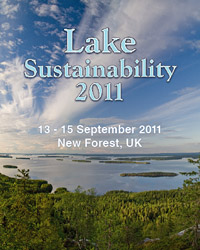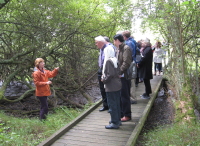Lake Sustainability 2011
First International Conference on Lake Sustainability
13 - 15 September 2011
New Forest, UK
Overview
 The first International Conference on Lake Sustainability took place at the Wessex Institute of Technology (WIT) Campus with the support of the University of Copenhagen, Denmark, represented by Professor Sven Jorgensen; and the Wessex Institute of Technology, represented by Professors Carlos A Brebbia and Viktor Popov.
The first International Conference on Lake Sustainability took place at the Wessex Institute of Technology (WIT) Campus with the support of the University of Copenhagen, Denmark, represented by Professor Sven Jorgensen; and the Wessex Institute of Technology, represented by Professors Carlos A Brebbia and Viktor Popov.
The conference on lake sustainability brought together researchers and practitioners from a wide range of different disciplines involved in the study of lake environments and ecosystems.
The management of lakes is facing numerous challenges nowadays, some of them related to natural and many others to anthropogenic causes. Climate change in particular will have serious consequences for lake environments, while man’s increasing demands will require an integrated approach to lake management, considering not only the entire watershed area but also the different socio-economic and ecological aspects. Any proposed solution will require improvements in ecosystems services, and the development of lake ecosystems. Furthermore, more information needs to be processed and shared regarding lake and habitat restoration.
Lake systems are complex and characterized by being in a continuous state of evolution and change. They can easily be disturbed, leading to major ecological or environmental disasters as evidenced by many cases in the past. Their behaviour requires careful analysis before attempts are made to alter existing conditions. Well documented disasters have emphasised the need to consider lake environments in their entirety, applying interdisciplinary approaches.
The conference dealt with all topics related to the behaviour of lakes, including physical, biological, pollution, water resources management, socio-economic aspects, restoration and exploitation.
Professor Carlos A Brebbia opened the conference by thanking all the delegates for their presence, particularly the invited presenters and Professor Sven Jorgensen, the keynote speaker.

Professor Brebbia then described the function of WIT as an organisation dedicated to knowledge transfer. This is accomplished by a variety of different activities, including research; working in collaboration with other institutions; training at PhD level; producing papers and books through the academic publishers, WIT Press; carrying out industrial research and consulting and the organisation of numerous international conferences and courses.
Professor Brebbia then pointed out the importance of a conference such as lake sustainability, the proceedings of which are distributed all over the world in addition to be permanently archived in the eLibrary of the Wessex Institute at https://www.witpress.com/elibrary He also mentioned the International Journals launched by the Wessex Institute, including the one on Design & Nature and Ecodynamics which is closely related to the conference topics.
Professor Brebbia ended his introductory remarks by again thanking the delegates for their contribution and hoping that they will have an occasion to hold discussions with WIT researchers, in spite of the tight conference schedule.
Keynote Address by Professor Sven Jorgensen

Professor Brebbia then introduced Sven Jorgensen, Professor of Analytic Chemistry at Copenhagen University. Professor Jorgensen, who is internationally renown in the field of ecosystems, has carried out extensive research in lakes. He is author of many papers and has received numerous recognitions for his outstanding work. He is recipient of the 2004 Prigogine Medal, established by the University of Siena and the Wessex Institute of Technology to honour the memory of the Nobel Prize winner who was the originator of the evolutionary physics and chemistry concepts underlying much of modern ecosystems theory.
Sven Jorgensen gave a keynote address and spoke about Structurally Dynamic Models (SDM) of lakes. This is a recent development in ecological modelling. These models have parameters which can vary to account for the adaptations and shifts in species compostion of the ecosystems. The models are particularly important for lakes because lakes present numerous changes as well as many structural changes. These parameters required for the model can be fed into expert systems and databases. The important point is that ecosystems have a high degree of heterogeneity in time and space. They include external factors and forcing functions.
The model developed by Professor Jorgensen uses exergy differences or gradients which account for the work produced in terms of chemical potential. This exergy, or energy provided for work, includes all genetic information.
Exergy is the amount of work that the system can perform, with the thermodynamic equations as the reference system. Ecosystems strive towards the highest possible amount of work energy. It can be considered as the thermodynamic translation of Darwin’s theory; the survival of the fittest.
Professor Jorgensen then described how the exergy of different organisms can be found. The amount of exergy constantly changes with time in response to external factors as well as internal processes.
The concepts developed using SDM principles can improve the quality of the model used both for calibration and validation. It has been successfully applied in 25 different cases, half of them in lakes, including Lake Mogan in Turkey and Lake Tai in China. The SDM can be used with confidence as proved by numerous applications. They include important and large lakes as well as smaller water bodies and take into account pollution effects. SDM can explain success or failure by bio-manipulation.
Professor Jorgensen ended his keynote address by referring to the Fuse Lake case in Denmark. It was decided to recover the lake ecosystem but it was claimed that such recovery was going to be slow. Because of this it was decided to make use of bio-manipulation to accelerate it. This will not only stop damaging chemicals and other pollutants being forced into the lake but also try to process the bottom sediments accumulated over many years. The SDM was used to model and predict the effects of different factors.
In conclusion, Professor Jorgensen asserted that SDMs offer a powerful tool for our better understanding of lake ecosystems.
Keynote Address by Professor Antonio Camacho
Another keynote presentation was delivered by Professor Antonio Camacho of the University of Valencia who has carried out outstanding work on Maritime Antarctic lakes. His presentation referred to the importance of those lakes as indicators of climate change.
The work originated following a project on Alpine and Antarctic lakes supported by the EU. The project considered the anthropogenic effects and pollution as well as climate change. The conclusion was that it was necessary to search for lakes not affected by climate change. The only such lakes are to be found in the poles. Antarctic Maritime lakes are free of ice for certain periods and were deemed to be ideal for climate change studies. They have remained in the same state for a huge period of time.
The studies carried out by Professor Camacho were on lakes located in the Graham peninsula. These lakes are still remote, isolated, uninhabited, and very sensitive to invasions. It was found that they have experienced changes due to global warming, with the glaciers in the region retreating. The lake ecosystems in the Antarctic are changing due to the invasion of other species, including man.
There are indicators of strong warming effects, earlier ice melting, higher biotic interaction and increased inversions. It is – Antonio said – as if the Antarctic ‘Ecosystems were moving to the bottom!’
Keynote Address by Ni-Bin Chang
The keynote address by Ni-Bin Chang from the University of Central Florida described the research carried out on Lake Okeechobee which covers an area of 1,800km2. The water discharges in the Everglades and its water balance is critical for the ecological balance of the area. The lake water is also needed for irrigation and human needs in an increasingly over-populated area. It is also essential to monitor the water quality of the lake, which is done through a network of stations. The pollution is complicated by the climate conditions and the number of hurricanes affecting the region, which have a great impact in a shallow lake like Okeechobee. The hurricanes disturb the lake ecology and in particular produce erosion and sediment transport problems which are the subject of continued research.
Excursions
The delegates were taken for a lunchtime visit to Bucklers Hard, an important historical site in the New Forest. It was there that many of the ships of the Royal Navy at the time of Nelson were built with local New Forest oak. The site, which is located on the Beaulieu River, displays a series of shipyard working cottages and an excellent museum where the history of the place is described as well as the way the ships were built.
At the end of the first conference day, a barbeque took place in the grounds of Ashurst Lodge, where the delegates had occasion to get to know each other better.
An important technical visit took place during the second day of the conference. The delegates were taken to Blashford Lakes which are located on the northern boundary of the New Forest. The presentations were given by a staff member of Wessex Water, describing the ecology and engineering aspects of the lakes. The presentations were followed by a guided tour of the lakes which included the description of experiments currently taking place to improve the quality of the water.
Following the visit and lunch, the participants returned by way of Winchester, where they stopped for a guided tour of its historic Cathedral, followed by a walk around the surrounding area. The visit was guided by Cathedral staff who were able to highlight the main points of interest in what is one of the most important religious buildings in the country.
Conference Dinner
 The conference dinner took place in Rhinefield House Hotel, another historical site of the New Forest. This hotel was originally one of the Royal hunting lodges in the Forest. The current building is approximately 150 years old and built in an impressive Scottish castle style. Built by a family who owned valuable coal mines in Nottingham, the building interior is decorated in a series of different styles. They range from a huge main hall with a roof similar to the House of Commons in London, to Spanish Mudejar smaller room; it reflects a particularly rich and period of country house architecture in Britain. The participants were entertained by a gifted local guitarist who played a series of classical and other well-known pieces on the Spanish guitar.
The conference dinner took place in Rhinefield House Hotel, another historical site of the New Forest. This hotel was originally one of the Royal hunting lodges in the Forest. The current building is approximately 150 years old and built in an impressive Scottish castle style. Built by a family who owned valuable coal mines in Nottingham, the building interior is decorated in a series of different styles. They range from a huge main hall with a roof similar to the House of Commons in London, to Spanish Mudejar smaller room; it reflects a particularly rich and period of country house architecture in Britain. The participants were entertained by a gifted local guitarist who played a series of classical and other well-known pieces on the Spanish guitar.
At the end of the dinner, Carlos thanked the delegates for having attended the conference and offered them as a souvenir a piece of pottery specially commissioned for the occasion. The potter, an artist from the New Forest area produces the pieces in the traditional way, including firing them in a wood burning oven rather than the electric ones used by most potters nowadays.
The success of the conference will ensure that it is reconvened in a place and at a date to be decided shortly.
Publication of Papers
Extended versions of the conference presentations are processed for publication in the International Journal of Design & Nature and Ecodynamics and will be available for purchase at the beginning of 2012.

 Wessex Institute
Wessex Institute